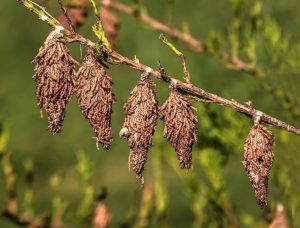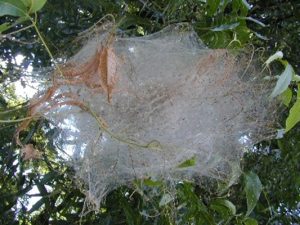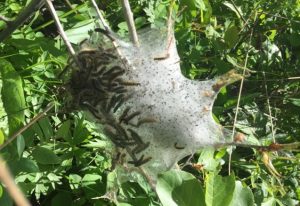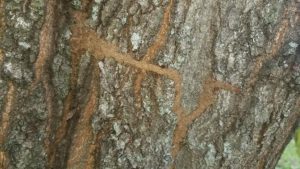I bet you didn’t know that every single day, your tree could be fighting for its life. Trees need a lot more attention than most owners provide. While it is true the common tree owner does not do any maintenance to their trees except when limbs fall. However, to guarantee tree health, survival, and desired appearance for your landscaping needs, maintaining the health of your tree is a necessity. The first step to maintaining the health of your trees is protecting them from unwanted pests that could eventually kill them before you know the damage has been done. Three of the very common insect pests in our area are termites, webworms, and my least favorite- bagworms.
Let’s start with bagworms. The scientific name is Thyridopteryx ephemeraformis. They are very common on the eastern half of the United States and most commonly affect conifers and many ornamental shrubs. They are the beginning stages of moths, and after they hatch, they form bags that hang from the tree typically growing to about an inch. This explains the term “bagworm.” With this “bag,” they are able to move from tree to tree feeding on the tree, thus killing it. The unfortunate fact about this insect is that they usually are not detected until the damage has been done. The good news is that you can prevent them using insecticides if caught early or as a preventative.

One insect that you probably thought was harmless is the webworm. The fall webworm, also known as the Hyphantria cunea as its scientific name, develops large webs around limbs or branches of tress. They are primarily targeting deciduous trees and feed on the leaves of the tree. Now you can see why this would be problematic because they are technically eating your tree. However, at first glance most people do not see the harm in them because they are unaware that while the caterpillars are in their webs, they are also feeding, and this is not just a hibernation time for them. Besides the unwanted appearance they present, they are also taking away vital nutrients for your tree to grow and thrive. With webworms present, your tree is having to work harder to provide the nutrients it needs to survive because of these unwanted pests. Webworms are a little bit easier to get rid of than other types of pests. You can remove them by hand or spray them with pesticides.


Now on to the next probably most dreaded insect- termites, also known as Isoptera. A common misconception is that termites only infest dead trees. This is false! Some termites head directly for live trees first! You can tell if termites are present if there are hollow cavities the termites have eaten through or along the tree. You can also check to see if you have termites at the base of your tree- they often create mud tubes along the bark. These are used for the termites to travel. We recommend if you suspect you have termites to call a professional. Termites are strong enough to eat enough of your tree away that it will compromise the tree and put it at risk of failing or dying which then leads to falling. Of course, like most things you can also prevent termites using insecticides but also controlling your property and making it a not-so-desired location for them. For example, while not all termites go for live wood, the majority of them go for dead or dried wood. You want to avoid stacking firewood near your house. Another common misconception is that leaving tree stumps is totally safe. While the stump has no threat of falling on your house, it could damage it in other ways. Stumps that are left from trees that have been cut down invite a feeding area for termites and other insects that may eventually move on to your house when they have had enough of the stump. It is always best to get a termite inspection at least once a year and get prevention, that is if you wish to keep your trees healthy on your property.



